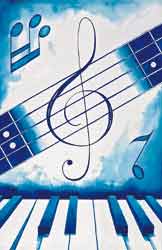|
Acquaticity: a substantial element of the language of music
Annely Zeni
“The water makes noise through the stones, it whistles, and shrills through the reeds, moaning, it gathers up deeply here and there towards the shore whilst in the middle runs a torrent as though there is no time to waste.” You can hear a lengthy harmony from one shore to another, the far away voices marvellously become nearer, pushed by the wind, broken by the syllables of water that  vary the sounds to infinity like the harmony of music”. That is how the “music” of water is seen by Corrado Alvaro in Gente d’Aspromonte: A music that always influences composers, creating a very long aquatic chapter in the productive panorama of any historiographical age. From Water Music by Haendel to aquaphones (water musical instruments) by Jacques Dudon. Water in the form of seas, rivers, streams, thunder-storms under the Debussy bridges (Reflets dan l’Eau, La mer), Saint-Saens (Aquarium), John Cage (another experimental Water-Music) Vivaldi (“La tempesta di mare” and at least the two thuderstorms of the season) Beethoven (sixth symphony) Rossini and Verdi (the thunderstorm of “Barbiere” and the epic of “Otello”. vary the sounds to infinity like the harmony of music”. That is how the “music” of water is seen by Corrado Alvaro in Gente d’Aspromonte: A music that always influences composers, creating a very long aquatic chapter in the productive panorama of any historiographical age. From Water Music by Haendel to aquaphones (water musical instruments) by Jacques Dudon. Water in the form of seas, rivers, streams, thunder-storms under the Debussy bridges (Reflets dan l’Eau, La mer), Saint-Saens (Aquarium), John Cage (another experimental Water-Music) Vivaldi (“La tempesta di mare” and at least the two thuderstorms of the season) Beethoven (sixth symphony) Rossini and Verdi (the thunderstorm of “Barbiere” and the epic of “Otello”.  The marine visions of Simon Boccanegra), Liszt and Respighi (“Jeau d’eau a Villa d’Este”, “Fontane di Roma”), Smetana (La Moldava) and Strauss (“Bel Danubio Blu!). Not to mention Wagner and the Ring, the alpha and omega of the legendary theatrical saga the Ring, symbol of creation, of the womb (water) on returning to infinity, firstly in the Bach and Bachlein labyrinth of Lied and Schubertiana. Next to description, whether direct, symbolic or even cryptic, acquaticity can be considered a substantial element of the language of music: Water flows like time, or rather like music, art of time par excellence, water passes through fingers like sound tickles the ear then switches off. Water adopts many forms and models itself in space, like music leaves trails in the space of the soul which receives it. Like a symbol of dynamism and a metaphor of fragility, water especially floods two musical ages: Firstly, the instrumental 1600s full of Toccata, Fantasia, Caprice, Follia, prismatic forms on every beat, surprisingly unpredictable in their paths as well as intimately painful (tear and lament water). Secondly, Romanticism, through pianistic liquidity Schubert accompaniments and the "rubati" of Chopin, to reach extreme limits – the cupio dissolvi alias “naufragar m’è dolce in questo mare” - by mahleriana memory. The marine visions of Simon Boccanegra), Liszt and Respighi (“Jeau d’eau a Villa d’Este”, “Fontane di Roma”), Smetana (La Moldava) and Strauss (“Bel Danubio Blu!). Not to mention Wagner and the Ring, the alpha and omega of the legendary theatrical saga the Ring, symbol of creation, of the womb (water) on returning to infinity, firstly in the Bach and Bachlein labyrinth of Lied and Schubertiana. Next to description, whether direct, symbolic or even cryptic, acquaticity can be considered a substantial element of the language of music: Water flows like time, or rather like music, art of time par excellence, water passes through fingers like sound tickles the ear then switches off. Water adopts many forms and models itself in space, like music leaves trails in the space of the soul which receives it. Like a symbol of dynamism and a metaphor of fragility, water especially floods two musical ages: Firstly, the instrumental 1600s full of Toccata, Fantasia, Caprice, Follia, prismatic forms on every beat, surprisingly unpredictable in their paths as well as intimately painful (tear and lament water). Secondly, Romanticism, through pianistic liquidity Schubert accompaniments and the "rubati" of Chopin, to reach extreme limits – the cupio dissolvi alias “naufragar m’è dolce in questo mare” - by mahleriana memory.
|
|